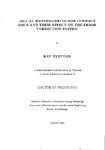DIGITAL WATERMARKING FOR COMPACT DISCS AND THEIR EFFECT ON THE ERROR CORRECTION SYSTEM
| dc.contributor.author | RYDYGER, KAY | |
| dc.contributor.other | School of Engineering, Computing and Mathematics | en_US |
| dc.date.accessioned | 2013-09-11T10:36:54Z | |
| dc.date.available | 2013-09-11T10:36:54Z | |
| dc.date.issued | 2002 | |
| dc.identifier | NOT AVAILABLE | en_US |
| dc.identifier.uri | http://hdl.handle.net/10026.1/1653 | |
| dc.description.abstract |
A new technique, based on current compact disc technology, to image the transparent surface of a compact disc, or additionally the reflective information layer, has been designed, implemented and evaluated. This technique (image capture technique) has been tested and successfully applied to the detection of mechanically introduced compact disc watermarks and biometrical information with a resolution of 1.6um x l4um. Software has been written which, when used with the image capture technique, recognises a compact disc based on its error distribution. The software detects digital watermarks which cause either laser signal distortions or decoding error events. Watermarks serve as secure media identifiers. The complete channel coding of a Compact Disc Audio system including EFM modulation, error-correction and interleaving have been implemented in software. The performance of the error correction system of the compact disc has been assessed using this simulation model. An embedded data channel holding watermark data has been investigated. The covert channel is implemented by means of the error-correction ability of the Compact Disc system and was realised by aforementioned techniques like engraving the reflective layer or the polysubstrate layer. Computer simulations show that watermarking schemes, composed of regularly distributed single errors, impose a minimum effect on the error correction system. Error rates increase by a factor of ten if regular single-symbol errors per frame are introduced - all other patterns further increase the overall error rates. Results show that background signal noise has to be reduced by a factor of 60% to account for the additional burden of this optimal watermark pattern. Two decoding strategies, usually employed in modern CD decoders, have been examined. Simulations take emulated bursty background noise as it appears in user-handled discs into account. Variations in output error rates, depending on the decoder and the type of background noise became apparant. At low error rates {r < 0.003) the output symbol error rate for a bursty background differs by 20% depending on the decoder. Differences between a typical burst error distribution caused by user-handling and a non-burst error distribution has been found to be approximately 1% with the higher performing decoder. Simulation results show that the drop of the error-correction rates due to the presence of a watermark pattern quantitatively depends on the characteristic type of the background noise. A four times smaller change to the overall error rate was observed when adding a regular watermark pattern to a characteristic background noise, as caused by user-handling, compared to a non-bursty background. | en_US |
| dc.language.iso | en | en_US |
| dc.publisher | University of Plymouth | en_US |
| dc.title | DIGITAL WATERMARKING FOR COMPACT DISCS AND THEIR EFFECT ON THE ERROR CORRECTION SYSTEM | en_US |
| dc.type | Thesis | |
| plymouth.version | Full version | en_US |
| dc.identifier.doi | http://dx.doi.org/10.24382/1480 | |
| dc.identifier.doi | http://dx.doi.org/10.24382/1480 |
Files in this item
This item appears in the following Collection(s)
-
01 Research Theses Main Collection
Research Theses Main


